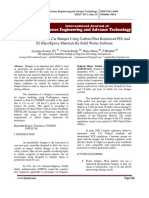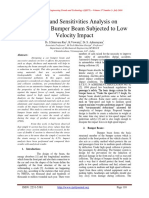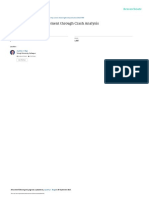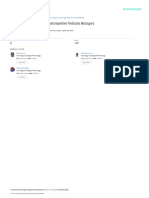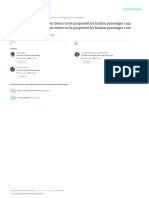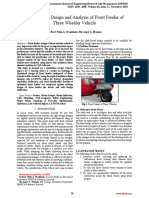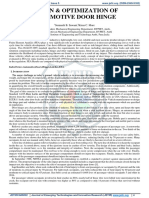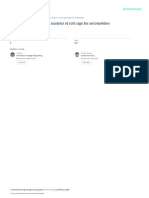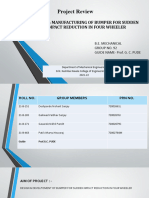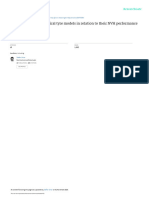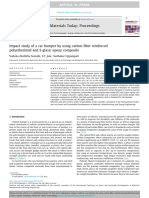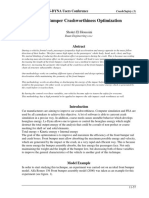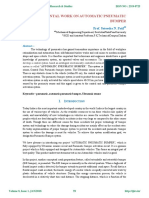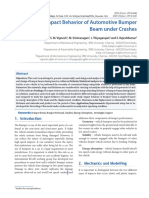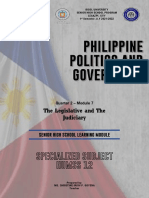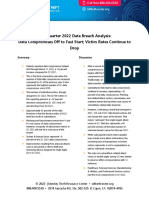Impact Analysis of A Car Bumper Using Carbon Fiber
Impact Analysis of A Car Bumper Using Carbon Fiber
Uploaded by
Sahaya robin singh MCopyright:
Available Formats
Impact Analysis of A Car Bumper Using Carbon Fiber
Impact Analysis of A Car Bumper Using Carbon Fiber
Uploaded by
Sahaya robin singh MCopyright
Available Formats
Share this document
Did you find this document useful?
Is this content inappropriate?
Copyright:
Available Formats
Impact Analysis of A Car Bumper Using Carbon Fiber
Impact Analysis of A Car Bumper Using Carbon Fiber
Uploaded by
Sahaya robin singh MCopyright:
Available Formats
CORE Metadata, citation and similar papers at core.ac.
uk
Provided by International Journal of Science Engineering and Advance Technology (IJSEAT)
International Journal of Science Engineering and Advance Technology, ISSN 2321-6905
IJSEAT, Vol 2, Issue 10 October-2014
Impact Analysis of A Car Bumper Using Carbon Fiber Reinforced PEI And
S2 Glass/Epoxy Materials By Solid Works Software
Ayyappa Swamy GV #1, P Satish Reddy #2, Matta Manoj #3, P.Bhaskar #4
ME Department, Prasiddha College of Engg and Technology, Anathavaram
1 2 3 4
swamy16@rocketmail.com, satish2436@gmail.com, mattamanoj13@gmail.com, smilybobbys@gmail.com
Abstract- Bumper is an important part which is used Federal Motor Vehicle Safety Standard No. 215
as protection for passengers from front and rear (FMVSS 215), "Exterior Protection," took effect on 1
collision. The intend of this study was to investigate September 1972 — when most automakers would
the structure and material employed for car bumper in begin producing their model year 1973 vehicles. The
one of the car manufacturer. In this study, the most standard prohibited functional damage to specified
important variables like material, structures, shapes and safety-related components such as headlamps and fuel
impact conditions are studied for analysis of the system components when the vehicle is subjected to
bumper beam in order to improve the crashworthiness barrier crash tests at 5 miles per hour (8 km/h) for front
during collision. and 2.5 miles per hour (4 km/h) for rear bumper
systems.
The simulation of a bumper is characterized
by impact modeling using Pro/Engineer, impact The standards were further beefed up for the
analysis is done by COSMOS according to the speed 1974 model year passenger cars with standardized
that is 13.3 m sec-1 (48 km h-1) given in order to height front and rear bumpers that could take angle
analyze the results. This speed is according to impacts at 5 mile-per-hour (8 km/h) with no damage to
regulations of Federal Motor Vehicle Safety Standards, the car's lights, safety equipment, and engine. In 1990,
FMVSS 208- Occupant Crash Protection whereby the IIHS conducted four crash tests on three different-year
purpose and scope of this standard specifies examples of the Plymouth Horizon. The results
requirements to afford impact protection for illustrated the effect of the changes to the U.S. bumper
passengers. regulations (repair costs quoted in 1990 United States
dollars).
Keywords-Bumper, Simulation, COSMOS,
FMVSS 208
In early 2009, Canada's regulation shifted to
I. INTRODUCTION harmonize with U.S. Federal standards and
international ECE regulations. Consumer groups are
upset with the change, but Canadian regulators assert
An automobile's bumper is the front-most or that the 4 km/h (2.5 mph) test speed is used worldwide
rear-most part, ostensibly designed to allow the car to and is more compatible with improved pedestrian
sustain an impact without damage to the vehicle's protection in vehicle-pedestrian crashes.
safety systems. They are not capable of reducing injury
to vehicle occupants in high-speed impacts, but are II TYPES OF BUMPERS
increasingly being designed to mitigate injury to
pedestrians struck by cars. Plastic bumper- Most modern cars use a
reinforced thermoplastic bumper, as they are
In 1971, the U.S. National Highway Traffic cheap to manufacture, easy to fit and absorb
Safety Administration (NHTSA) issued the country's more energy during a crash.
first regulation applicable to passenger car bumpers.
www.ijseat.com Page 565
International Journal of Science Engineering and Advance Technology, ISSN 2321-6905
IJSEAT, Vol 2, Issue 10 October-2014
Body kit bumper- Modified cars often now foam. Better bumpers often have hydraulic shock
have a full body kit rather than just a front and absorbers instead of, or in addition to, the foam.
rear bumper. These kits act as a skirt around
the entire body of the car and improve Today's plastic auto bumpers and fascia systems
performance by reducing the amount of air are aesthetically pleasing, while offering advantages to
flowing underneath the car and so reducing both designers and drivers. The majority of modern
drag. plastic car bumper system fascias are made of
Carbon fiber bumper- Carbon fiber body work thermoplastic olefins (TPOs), polycarbonates,
is normally the thing of super-cars, but many polyesters, polypropylene, polyurethanes, polyamides,
car companies, and specialist modifiers, are or blends of these with, for instance, glass fibers, for
starting to use it for replacement body part on strength and structural rigidity. The use of plastic in
everyday cars. auto bumpers and fascias gives designers a tremendous
amount of freedom when it comes to styling a
Steel bumper- Originally plated steel was used prototype vehicle, or improving an existing model.
for the entire body of a car, including the Plastic bumpers contain reinforcements that allow them
bumper. This material worked well, as it was to be as impact-resistant as metals while being less
very strong in a crash, but it was very heavy expensive to replace than their metal equivalents.
and dented performance. As car engine design Plastic car bumpers generally expand at the same rate
has improved, steel bumpers have pretty much as metal bumpers under normal driving temperatures
disappeared for anything except classic cars. and do not usually require special fixtures to keep them
Replacing one involves a lot of searching for in place.
scrap cars or having one specially made.
III MATERIALS USED IN BUMPER IV DESIGN AND MODELING-Actual Car Bumper
At one time, most car bumpers were made of steel.
Then, most were made of chrome or a chrome-plated
material. Today, car bumpers can be made from
anything from chrome-plated material to a variety of
different rubber materials or plastics. This makes
detailing car bumpers somewhat more complicated, as
bumpers made from different materials require very
different detailing treatments.
Detailing a chrome-plated bumper requires a bit of
Fig-1: Model of a Car Bumper
patience and a light sanding touch, but it is certainly
something that even the most casual car owner can
accomplish in a day or less. The primary enemy of
chrome-plated bumpers is oxidation (rust). The longer
you allow rust spots to remain on your bumper, the
more difficult the detailing process is going to be.
Bumpers on most new cars are color-coordinated
plastic "wrappers," molded sleekly around the front
and back ends of the vehicles. They may please the
eye, but whether these bumpers protect the vehicle they
surround from damage in low-speed impacts is another
matter. According to the National Institute for
Highway Safety, how well the car is protected depends
Fig-2: Stresses for actual Bumper-Alloy Steel at Speed
largely on what's underneath the plastic. Bumper
systems usually include a reinforcement bar plus 48km/hr
energy-absorbing material, such as polypropylene
www.ijseat.com Page 566
International Journal of Science Engineering and Advance Technology, ISSN 2321-6905
IJSEAT, Vol 2, Issue 10 October-2014
Fig-3: Stresses for actual Bumper-Alloy Steel at Speed Fig-6: Stress for actual bumper-S2glass/Epoxy at speed
120 km/hr 48Km/hr
Fig-7: Stress for actual bumper-S2glass/Epoxy at speed
120 Km/hr
Fig-4: Stress for actual bumper-Carbon Fiber
Reinforced PEI at speed 48 km/hr V DESIGN AND MODELING- Modified Bumper
Fig-5: Stress for actual bumper-Carbon Fiber
Reinforced PEI at speed 120 Km/hr
www.ijseat.com Page 567
International Journal of Science Engineering and Advance Technology, ISSN 2321-6905
IJSEAT, Vol 2, Issue 10 October-2014
Fig-8: Stress for modified bumper-alloy steel at speed
48Km/hr
Fig-12: Stress comparison at speed 120 km/hr
Fig-9: Stress for modified bumper-Carbon fiber
reinforced PEI at speed 48km/hr
Fig-10: Stress for modified bumper-S2glass/Epoxy Fig-13: Weight Comparison
at speed 48km/hr VI CONCLUSION
1. In our thesis, actual model of a car bumper is
designed and a modified model to the actual is also
designed.
2. Impact analysis is done on the car bumper for
different speeds of 48Km/hr and 120Km/hr. The
analysis is done on the car bumper for different
materials Alloy Steel, S2 Glass/Epoxy and Carbon
Fiber Reinforced PEI.
3. Present used material for car bumper is steel. By
using steel the weight of the car bumper is more
but by using composites the weight of the bumper
is reduced since densities are very less compared
with steel. By using S2 Glass/Epoxy, the weight is
Fig-11: Stress comparison at speed 48 km/hr almost reduced by 4Kgs and by using carbon Fiber
Reinforced PEI it is almost reduced by 5Kgs.
www.ijseat.com Page 568
International Journal of Science Engineering and Advance Technology, ISSN 2321-6905
IJSEAT, Vol 2, Issue 10 October-2014
P. Ballard and F. Marikar, TMS-New Jersey,
4. By observing the analysis results for both the 1990, pp 85-96.
designs, the analyzed stress and displacement
values are more for the actual model than the 5. T. W. Clyne, An Introductory Overview of
modified model. So it can be concluded that MMC System, Types and Developments in
modifying the original design is better. Comprehensive Composite Materials,; Metal
Matrix Composites, T. W Clyne (ed), Elsevier,
5. By observing the analysis results, the analyzed Vol-3 (2000): pp.1-26.
stress values when steel and PEI are used are safe
when impacted at a speed of 48km/hr, but the 6. L.M.Manocha & A.R. Bunsell “Advances in
stress values for those materials when impacted at composite materials”, Pergamon Press, Oxford,
a speed of 120km/hr is not safe since their Vol.2, (1980) p 1233-1240.
analyzed stress values are more than their
respective yield stress values. So using Steel and
Carbon Fiber-Reinforced PEI at a speed of
7. Berghezan,A.Nucleus,8(5),(1966),(Nucleus A
Editeur,1,rhe,Chalgrin,Paris, 16(e).
120km/hr is not better.
6. But the analyzed stress values when S2 8. Suchetclan Van, Philips Res. Repts. Volume 27,
Glass/Epoxy is used impacted at both the speeds is (1972): p. 28.
safe since the stress values are less than its yield
stress value. So we can conclude that using S2 9. Agarwal B.D. and Broutman L.J., “Analysis and
Glass/Epoxy is better. performance of fiber composites” John Wiley
& Sons, New York, (1980): p. 3-12.
VII SCOPE OF FUTURE RESEARCH
10. Bledzki A K, Gassan J., “Composites
By this thesis, it is proved analytically that reinforced with cellulose based fibers”.
using composites is better for bumper than steel due to Progress in Polymer Science , Volume 24,
the reduction in weight and also stresses. But more (1999): p. 221-274
experiments have to done for feasible using of
composites considering cost and other conditions. 11. Hosseinzadeh RM, Shokrieh M, and Lessard
LB, “Parametric study of automotive
VIII REFERENCES composite bumper beams subjected to low -
velocity impacts”, J. Composite Stuct., 68
(2005):419 - 427.
1. A.K.Dhingra, “metal replacement by
composite”, JOM 1986, Vol 38 (03), p. 17. 12. Marzbanrad JM, Alijanpour M, and Kiasat MS,
“Design and analysis of automotive bumper
beam in low speed frontal crashesh”, Thin
2. K.Upadhya, “composite materials for aerospace Walled Struct., 47 (2009): 902-911.
applications, developments in ceramic and
metal matrix composites”, Kamaleshwar
Upadhya, ed., warren dale, PA: TMS
publications, 1992, pp. 3-24.
3. Greg Fisher, “Composite: Engineering the
ultimate material”, Am. Ceram. Soc, Bull, Vol.
63 (2) (1984): pp. 360-364.
4. T.G.Nieh, K.R. Forbes, T.C. Chou and J.
Wadsworth, “Microstructure and deformation
properties of an Al2O3-Ni3Al composite from
room temp to 14000C”, High Performance
Composites for the 1990’s Eds. S. K. Das, C.
www.ijseat.com Page 569
You might also like
- FIDIC Contracts in Europe A Practical Guide To Application DonaldDocument692 pagesFIDIC Contracts in Europe A Practical Guide To Application DonaldvalerykapustinaaaNo ratings yet
- P&ID SymbolsDocument1 pageP&ID SymbolsAnonymous jUDyr57100% (1)
- Case Study HRMDocument10 pagesCase Study HRMAjay Joseph25% (4)
- Pratt & Whitney Canada: Maintenance Manual MANUAL PART NO. 3043512Document12 pagesPratt & Whitney Canada: Maintenance Manual MANUAL PART NO. 3043512Michael Quintero100% (2)
- Submitted By: Structural Analysis of Modified Bumper of Car With Honeycomb Structure Using AnsysDocument18 pagesSubmitted By: Structural Analysis of Modified Bumper of Car With Honeycomb Structure Using AnsysAlex Pandian SNo ratings yet
- Guia RDocument32 pagesGuia RJames Albert BarreraNo ratings yet
- ATM USe Case SamplesDocument25 pagesATM USe Case SamplesvisualdomainNo ratings yet
- Impact Analysis of A Car Bumper Using Carbon Fiber Reinforced PEI and S2 Glass/Epoxy Materials by Solid Works SoftwareDocument5 pagesImpact Analysis of A Car Bumper Using Carbon Fiber Reinforced PEI and S2 Glass/Epoxy Materials by Solid Works SoftwareSushant VanveNo ratings yet
- Comparative Analysis of Frontal Car Bumper During ImpactDocument5 pagesComparative Analysis of Frontal Car Bumper During ImpactInternational Journal of Application or Innovation in Engineering & ManagementNo ratings yet
- Impact Analysis of Car Front Bumper To Enhance CrashworthinessDocument5 pagesImpact Analysis of Car Front Bumper To Enhance CrashworthinessBrhane TeklayNo ratings yet
- Journal of Automobile Engineering and Applications Study of Two-Distinct Automotive Bumper Beam Designs During Low Speed ImpactsDocument14 pagesJournal of Automobile Engineering and Applications Study of Two-Distinct Automotive Bumper Beam Designs During Low Speed ImpactssandeepNo ratings yet
- Composite Materials Literature Review For Car Bumber: August 2016Document12 pagesComposite Materials Literature Review For Car Bumber: August 2016meita alviraNo ratings yet
- Optimization of Car BumperDocument10 pagesOptimization of Car BumperRobert WilkinsonNo ratings yet
- Optimization of Car BumperDocument10 pagesOptimization of Car Bumpervinay kumarNo ratings yet
- 1 s2.0 S2214785320364439 MainDocument7 pages1 s2.0 S2214785320364439 MainJaliJaNo ratings yet
- Design and Sensitivities Analysis On Automotive Bumper Beam Subjected To Low Velocity ImpactDocument12 pagesDesign and Sensitivities Analysis On Automotive Bumper Beam Subjected To Low Velocity ImpactarthurNo ratings yet
- Godara 2020Document7 pagesGodara 2020Vipin MishraNo ratings yet
- Design and Crash Analysis of Passenger Car Frontal Bumper Beam Using Hypermesh and RadiossDocument5 pagesDesign and Crash Analysis of Passenger Car Frontal Bumper Beam Using Hypermesh and RadiossAnup M UpadhyayaNo ratings yet
- Crash Analysis of Bumper Assembly With Solver To Improvise The Design For Impact Tests IJERTV2IS60577Document8 pagesCrash Analysis of Bumper Assembly With Solver To Improvise The Design For Impact Tests IJERTV2IS60577Suryadevara Mouneesh ChowdaryNo ratings yet
- Study of Impact On Car Bumper-A Literature ReviewDocument7 pagesStudy of Impact On Car Bumper-A Literature ReviewIJIRSTNo ratings yet
- Bumper BeamDocument4 pagesBumper BeamJournalNX - a Multidisciplinary Peer Reviewed JournalNo ratings yet
- Explicit Dynamics Crash Analysis of CarDocument8 pagesExplicit Dynamics Crash Analysis of Caruday chavanNo ratings yet
- Bumper Design Enhancement Through Crash AnalysisDocument9 pagesBumper Design Enhancement Through Crash AnalysisSanthosh KumarNo ratings yet
- Crash Analysis On The Automotive Vehicle BumperDocument6 pagesCrash Analysis On The Automotive Vehicle BumperSuryadevara Mouneesh ChowdaryNo ratings yet
- Crash Analysis On The Automotive Vehicle BumperDocument7 pagesCrash Analysis On The Automotive Vehicle BumperBerk Hasan AslanNo ratings yet
- Ijet V2i5p22 PDFDocument6 pagesIjet V2i5p22 PDFInternational Journal of Engineering and TechniquesNo ratings yet
- Car BumperDocument41 pagesCar BumperWebsoft Tech-HydNo ratings yet
- Impact Analysis On Car BumperDocument5 pagesImpact Analysis On Car Bumperkailashparmar1No ratings yet
- Crash Analysis of Car Chassis Frame UsinDocument19 pagesCrash Analysis of Car Chassis Frame Usinuday chavanNo ratings yet
- Iajicte 2022 8 1 12Document11 pagesIajicte 2022 8 1 12uday chavanNo ratings yet
- Advanced Simulation Techniques For Low Speed Vehicle ImpactsDocument12 pagesAdvanced Simulation Techniques For Low Speed Vehicle ImpactsFlorencia Sabrina EnriquezNo ratings yet
- Improving The Crashworthiness of An Automobile Bumper: Arun Basil Jacob Arunkumar O.NDocument13 pagesImproving The Crashworthiness of An Automobile Bumper: Arun Basil Jacob Arunkumar O.NyousefNo ratings yet
- Design and Fabrication of Composite Bumper For Light Passenger VehiclesDocument5 pagesDesign and Fabrication of Composite Bumper For Light Passenger Vehicleshimanshu pandeyNo ratings yet
- Development of Car Hood For Stiffness Improvement Using FEA SystemDocument4 pagesDevelopment of Car Hood For Stiffness Improvement Using FEA Systemrocky boyNo ratings yet
- Khedkar 2020 J. Phys. Conf. Ser. 1706 012169Document9 pagesKhedkar 2020 J. Phys. Conf. Ser. 1706 012169Brhane TeklayNo ratings yet
- Design of Hood Stiffener of A Sedan Car ForDocument7 pagesDesign of Hood Stiffener of A Sedan Car ForAli GüneşNo ratings yet
- Hood 2Document13 pagesHood 2devise.kaustubhNo ratings yet
- Updated Literature Review With 30 AuthorsDocument4 pagesUpdated Literature Review With 30 AuthorswakjiraNo ratings yet
- Design and Analysis of Car BumperDocument62 pagesDesign and Analysis of Car BumperSanjeev Kumar75% (4)
- 1 s2.0 S2590123024001804 MainDocument11 pages1 s2.0 S2590123024001804 MainwakjiraNo ratings yet
- Design of A CFRP Composite Monocoque Simulation ApproachDocument8 pagesDesign of A CFRP Composite Monocoque Simulation ApproachGregory Aguilera LopesNo ratings yet
- Rear Impact and Side Intrusion of Two Wheeler With A Bus: Praveen Kumar.Y DR - Vinod Banthia Dr. Badarinath AmbatiDocument8 pagesRear Impact and Side Intrusion of Two Wheeler With A Bus: Praveen Kumar.Y DR - Vinod Banthia Dr. Badarinath AmbatiGautam SharmaNo ratings yet
- Designand Analysisof Composite Sandwich Struturefor Automotive ApplicationDocument54 pagesDesignand Analysisof Composite Sandwich Struturefor Automotive Applicationparthadhav2020.mech1No ratings yet
- Ijerm Review Paper 02Document6 pagesIjerm Review Paper 02Sagar GalgatNo ratings yet
- Design Optimization of Car Front Hood For Pedestrian SafetyDocument9 pagesDesign Optimization of Car Front Hood For Pedestrian SafetyprakashNo ratings yet
- JETIRCA06002Document7 pagesJETIRCA06002Sumit SehgalNo ratings yet
- Are View On Automotive Bumper Beam Design and AnalysisDocument16 pagesAre View On Automotive Bumper Beam Design and AnalysisBrhane TeklayNo ratings yet
- Safety Science: A. Masoumi, Mohammad Hassan Shojaeefard, Amir NajibiDocument10 pagesSafety Science: A. Masoumi, Mohammad Hassan Shojaeefard, Amir NajibiTarunNo ratings yet
- Group 4 Final Project Matsci LabDocument11 pagesGroup 4 Final Project Matsci LabRoi Vincent AnitNo ratings yet
- 30 Automotive Applications of Plastics: Past, Present, and FutureDocument23 pages30 Automotive Applications of Plastics: Past, Present, and FuturePatito Lisbhet Romero BuenoNo ratings yet
- GIRIJOURNALDocument19 pagesGIRIJOURNALZied AbidiNo ratings yet
- Polymer Foam Core Aluminum Sandwich Lightweight Car Hood For Pedestrian ProtectionDocument5 pagesPolymer Foam Core Aluminum Sandwich Lightweight Car Hood For Pedestrian ProtectionAjayNo ratings yet
- Improvised Car Bumper With Carbon Fiber Reinforced Plastic PDFDocument11 pagesImprovised Car Bumper With Carbon Fiber Reinforced Plastic PDFSITI AMINAH BINTI GHAZALINo ratings yet
- Improvised Car Bumper With Carbon Fiber Reinforced PlasticDocument12 pagesImprovised Car Bumper With Carbon Fiber Reinforced PlasticSITI AMINAH BINTI GHAZALINo ratings yet
- Bumper Beams - Absorbing The Bulk of Energy and Providing Protection To The Rest of The VehicleDocument13 pagesBumper Beams - Absorbing The Bulk of Energy and Providing Protection To The Rest of The VehicleSahaya robin singh MNo ratings yet
- Safety and Reliability Enhancement of Car Front Bumper For Different Materials Using AnsysDocument4 pagesSafety and Reliability Enhancement of Car Front Bumper For Different Materials Using AnsysSahaya robin singh MNo ratings yet
- Aylor LimitationsCurrentBumper 2005Document9 pagesAylor LimitationsCurrentBumper 20051644887No ratings yet
- Different Type of Crash Testing: Vidiyasagar Gavali, Dipak Dond, Ankit KumarDocument2 pagesDifferent Type of Crash Testing: Vidiyasagar Gavali, Dipak Dond, Ankit KumarerpublicationNo ratings yet
- Design Optimisation of Composite Bumper Beam With Variable Cross-Sections For Automotive VehicleDocument14 pagesDesign Optimisation of Composite Bumper Beam With Variable Cross-Sections For Automotive VehicleBrhane TeklayNo ratings yet
- Jcs 07 00162 v2Document16 pagesJcs 07 00162 v2emaadyesyesNo ratings yet
- Group 92 Final ProjectDocument20 pagesGroup 92 Final ProjectVaibhav GaikwadNo ratings yet
- Uhlar Heyder KoenigDocument23 pagesUhlar Heyder KoenigKaushal PanchalNo ratings yet
- ask recent MATR paperDocument7 pagesask recent MATR paperJaliJaNo ratings yet
- Tsai 2009Document13 pagesTsai 2009nayenzaman6No ratings yet
- Front Bumper PDFDocument6 pagesFront Bumper PDFsayedNo ratings yet
- Rear Impact Danger: Warning – Auto Passengers & Driver Beware!From EverandRear Impact Danger: Warning – Auto Passengers & Driver Beware!No ratings yet
- Experimental Work On Automatic Pneumatic BumperDocument8 pagesExperimental Work On Automatic Pneumatic BumperSahaya robin singh MNo ratings yet
- Simulation Methods For Bumper System Development Pdf-ModifyDocument86 pagesSimulation Methods For Bumper System Development Pdf-ModifySahaya robin singh MNo ratings yet
- Design and Development of Automatic Pneumatic Bumper SystemDocument6 pagesDesign and Development of Automatic Pneumatic Bumper SystemSahaya robin singh MNo ratings yet
- Bumper Beams - Absorbing The Bulk of Energy and Providing Protection To The Rest of The VehicleDocument13 pagesBumper Beams - Absorbing The Bulk of Energy and Providing Protection To The Rest of The VehicleSahaya robin singh MNo ratings yet
- Current Trends in Bumper Design For Pedestrian ImpactDocument16 pagesCurrent Trends in Bumper Design For Pedestrian ImpactSahaya robin singh MNo ratings yet
- Impact Behavior of Automotive BumperDocument4 pagesImpact Behavior of Automotive BumperSahaya robin singh MNo ratings yet
- Crash Simulation and Development of Automotive Bumper Impact Beam Design For Weight ReductionDocument6 pagesCrash Simulation and Development of Automotive Bumper Impact Beam Design For Weight ReductionSahaya robin singh MNo ratings yet
- MSC - NASTRAN Random Vibration Example: Seismic Mass Frequency ResponseDocument7 pagesMSC - NASTRAN Random Vibration Example: Seismic Mass Frequency ResponseManoj ManoharanNo ratings yet
- Morfe Vs MutucDocument7 pagesMorfe Vs MutucBLNNo ratings yet
- MODULE 7: The Legislative and The JudiciaryDocument13 pagesMODULE 7: The Legislative and The JudiciarytaffytaNo ratings yet
- 55-American Home Assurance Co. vs. Antonio Chua, 309 SCRA 250 (1999)Document6 pages55-American Home Assurance Co. vs. Antonio Chua, 309 SCRA 250 (1999)Jopan SJNo ratings yet
- Mahfuzur Rahman Bhuiyan L5DC AD Assignment September-2015Document9 pagesMahfuzur Rahman Bhuiyan L5DC AD Assignment September-2015Lubna AkterNo ratings yet
- Logistics Sales & Procurement CASE STUDYDocument4 pagesLogistics Sales & Procurement CASE STUDYAdarsh SannagoudaraNo ratings yet
- International Marketing Plan For The Export of "Shirohana Flowers" To GermanyDocument113 pagesInternational Marketing Plan For The Export of "Shirohana Flowers" To Germanyken mainaNo ratings yet
- Financial Analysis 2Document4 pagesFinancial Analysis 2Meynard AguilarNo ratings yet
- CheatSheet Python 2 - Data StructuresDocument1 pageCheatSheet Python 2 - Data StructuresERICH PINZONNo ratings yet
- A2. PLS 140106 A G MST 001 - Architectural Method Statement - REV 0.2Document60 pagesA2. PLS 140106 A G MST 001 - Architectural Method Statement - REV 0.2Mohammad Hadoumi SaldanNo ratings yet
- PLURIMA CatalogueDocument24 pagesPLURIMA Cataloguelucas.lafaurie8No ratings yet
- Tutorial 1 Answer PDFDocument2 pagesTutorial 1 Answer PDFYougoige LowNo ratings yet
- Screenshot 2023-05-01 at 9.56.55 PMDocument2 pagesScreenshot 2023-05-01 at 9.56.55 PMketansanwalNo ratings yet
- JSE Certification 1 SyllabusDocument4 pagesJSE Certification 1 SyllabusJohn P. GibsonNo ratings yet
- Introduction To Kanban Boards: @proofhubDocument20 pagesIntroduction To Kanban Boards: @proofhubZia UddinNo ratings yet
- PBL-1 - MN506 AnsweredDocument3 pagesPBL-1 - MN506 AnsweredSnd CplsNo ratings yet
- Swiss Finance Banking, FinanceDocument639 pagesSwiss Finance Banking, FinancePaulino Aguilera MalagónNo ratings yet
- One Pager - Q1 2022 Data Breach AnalysisDocument5 pagesOne Pager - Q1 2022 Data Breach AnalysisFairouz MustafaNo ratings yet
- Roland Full Tone ListDocument1 pageRoland Full Tone ListAlfredo A. Elacion Jr.No ratings yet
- Clinical Governance and Risk Management. 2005Document40 pagesClinical Governance and Risk Management. 2005Anonymous 9PcFdakHcNo ratings yet
- Pocket Quick Reference Guide 2012 AMS51-E v2Document16 pagesPocket Quick Reference Guide 2012 AMS51-E v2samanNo ratings yet
- IIPGCMS - HomeDocument1 pageIIPGCMS - Homesathisha123No ratings yet
- PDF IntegrationDocument9 pagesPDF IntegrationKvn ReddyNo ratings yet







